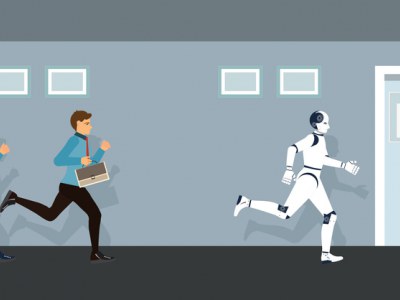The importance of learning in the workplace
The importance of learning in the workplace

Picture a typical home office: there is a desk next to a window with a laptop on it, a steaming cup of coffee, a printer, a chair, a rubbish bin and maybe a notepad or plant. Now imagine this picture of a home office is actually an image on a screen in front of you and you have 45 seconds to identify the potential security risks of this setting.
You click on the bin and a voiceover says: “One man’s trash, is another man’s treasure. Criminals love old bank statements, utility bills, personal data; it’s all a criminal needs to steal your ID. This treasure in your trash is also useful to socially engineer your trust; a scammer can sound legitimate if they have a little of your accurate personal information.”
Next you click on the window. “Imagine accidentally talking about an unreleased product or sensitive customer information with the window wide open,” says the voiceover, which goes on to outline the risks involved with each object you have selected.
This is a course devised by Vivida, a tech company that creates immersive learning experiences for corporate training in areas including cybersecurity, and diversity and inclusion for companies including Sky and Lloyds Banking Group.
Simeon Quarrie, the company’s founder and chief executive, grew up in the 1980s and says he struggled with the traditional classroom environment of worksheets and copying off the blackboard. “It didn’t resonate with me,” he recalls. His parents were worried, he was worried. “But then I realised that when the learning involved creativity, storytelling and interactivity, then I got it.”
This experience inspired him to set up Vivida. He began with video learning, but soon discovered virtual reality and immersive environments. “We get to build an environment that aids the learning and places people directly within that environment,” says Quarrie. In these courses, participants become cyber-digital forensic experts. They get to “examine the evidence from a past criminal case and understand how criminals attempt to scam you and your colleagues”, he says.
Quarrie argues that this approach changes how we learn, including our posture. Instead of leaning back while watching a video, participants lean forward and engage with the digital scenario. They review criminal interview tapes, consider the evidence and then analyse what they have learnt.
“We’re now competing with other devices, different distractions,” he says. “The environment that we learn in is no longer the carefully controlled corporate environment.” It is therefore crucial to provide learning experiences that are engaging.
New digital learning environment
In the past, employees were encouraged to learn new skills by going on a specific training course. Today, continuous learning is an integral part of people’s working lives; whether they’re employed or self-employed, people learn new skills from online courses and YouTube and TikTok videos, for example.
So, what gets classified as learning, particularly in a digital world? Global human resources analyst Josh Bersin says: “Any form of digital content is a form of learning. It could be documents, emails, recorded conversations, recorded meetings, videos. That’s why capturing digital content is so valuable because sometimes you’ll be in a staff meeting and somebody will say something and everybody will go, wow, I didn’t know that; all of a sudden you’ve created a live learning experience.”
He adds that “a lot of the learning that’s going on in business right now is actually being developed by employee groups for each other, without training people being involved”.
What’s more, according to research by LinkedIn, 75 per cent of learning and development professionals say community-based learning is now more important to their businesses than before the coronavirus pandemic hit and 94 per cent agree teams that learn together are ultimately more successful. A third of business leaders say reskilling and upskilling employees is a top priority for 2021.
Commenting on the impact the pandemic has had, Janine Chamberlin, senior director at LinkedIn, says: “I think it has lit a fire under digital learning, because the environment that companies are operating in is changing so quickly right now. To make sure companies can keep up with that, their employees need to continuously build new skills to get ahead of what’s coming next.”
Teaching soft and hard skills
Chamberlin points out that companies are not just looking for people to learn hard skills, like learning to code, they are also looking for them to develop their emotional intelligence and improve inclusion in their business.
When it comes to the former, the most popular courses on LinkedIn Learning over the past year have included learning Python computer programming language, training in Excel and the foundations of online marketing. Popular soft skill courses have included time management, strategic thinking, communicating with confidence and developing emotional intelligence. Overall, the platform, which offers 16,700 courses in seven languages, has seen the hours people spend on its courses double over the past year.
Research has shown that the most successful digital learning combines various interactive elements. When people watch a video, for example, having a structured discussion led by an instructor afterwards with their colleagues can be helpful. It improves people’s memory of the content by 25 per cent, according to a 2018 study led by Dr Kana Okano, a cognitive scientist at Tufts University in Massachusetts.
It is clear companies that foster a culture of learning are more likely to succeed and adapt to future challenges. “A clear sign of a dysfunctional company is when people say they don’t have enough time for learning,” says Bersin.
He argues that managers need to give people time to reflect during meetings, encourage people to take time to learn how to be better at their job, send them on courses as well as buying learning content, including books, and connect people so they can learn from each other. Bersin adds: “Companies have to realise that giving people unscheduled time is a huge productivity improvement because it gives them a chance to learn.”








